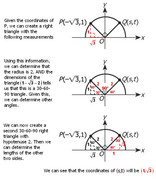Brent@GMATPrepNow wrote:ani781 wrote:
Points P, Q lie on the circle with center O. What is the value of S ?
a) 1/2
b) 1
c) 2^(1/2)
d)3^(1/2)
e) (2^1/2)/2[/img]
Here's one approach:

So, s = 1
Answer:
B
Cheers,
Brent
Hello Brent,
Thanks for the explanation. I was wondering that in the 3rd diagram that you have, once we know the value of OQ i.e. 2, what if we draw a straight line from P to Q and then use pythogoras theorem
i.e. 2^2 + 2^2 = PQ^2
=> PQ = 2 sq.root (2)
Hence, the distance from the Y axis to Q in line PQ is (2 sq. root (2))/2 = sq. root (2) and then this distance would the value of s. I was just wondering why this is in-correct? Thanks a lot for your help.
Best Regards,
Sri
